Senior Iranian military officials have continued to suggest that they will carefully calibrate Iran’s response to Israel’s killing of senior IRGC commanders in Syria. This careful approach aims to avoid a direct war with Israel. Iranian Armed Forces Chief of the General Staff Major General Mohammad Bagheri said on April 6 that Iran will strike Israel “at the right time” during a commemoration ceremony for the IRGC officers killed in the likely Israeli airstrike on April 1[i] The Military Affairs Adviser to the Iranian Supreme Leader Major General Yahya Rahim Safavi separately said during a similar commemoration ceremony on April 7 that Iran “must wait for the right time” to deliver its response.[ii] Several senior Iranian clerics close to the Office of the Supreme Leader endorsed “strategic patience”—a long-standing regime policy that involves not immediately conducting a major response to Israeli attacks—in their weekly sermons on April 5.[iii] Such comments support CTP-ISW’s assessment that Iran seeks to avoid a direct military confrontation against the United States and Israel. Strategic patience does not exclude an eventual Iranian retaliation, however.[iv]
Lebanese Hezbollah Secretary General Hassan Nasrallah on April 8 warned that Iran will retaliate for the April 1 Israeli airstrike, illustrating the possibility of an eventual response to the attack.[v] Nasrallah’s made these comments during a Hezbollah ceremony for IRGC commander Mohammed Reza Zahedi in Beirut. Nasrallah said that Iran has a ”natural right” to retaliate against the airstrike because it represented ”an attack on Iranian territory.”[vi] Nasrallah added that the United States and Israel recognize that an Iranian response to the attack is ”inevitably coming.”[vii] Zahedi spearheaded Iranian engagement with Hezbollah and most recently commanded the IRGC Quds Force unit responsible for overseeing operations in Lebanon, Jordan, Syria, and the Palestinian Territories.[viii] Zahedi was the only non-Lebanese member of Hezbollah’s Shura Council, which is led by Nasrallah and serves as the groups’ central decision-making authority.[ix]
Arabic-language media outlet Jadeh Iran reported on April 7 and 8 that Iran has conditioned its potential response to the April 1 Israeli strike on a ceasefire in Gaza. Arabic-language outlet Jadeh Iran reported on April 7 and 8 that Iran informed the United States that it would not retaliate against Israel for the April 1 strike if the United States could secure a ceasefire in the Gaza Strip between Israel and Hamas, citing “an anonymous Arab diplomatic source.”[x] Jadeh Iran is an outlet founded by an al Jazeera journalist. An Iranian Foreign Affairs Ministry official told Kuwait-based newspaper Al Jarida on April 8 that the Iranian Foreign Affairs Ministry told the United States that Iran would not respond to the April 1 Israeli airstrike if there was ”a ceasefire in Gaza.”[xi] The US State Department spokesperson denied these reports on April 8.[xii] The Jadeh Iran reporting coincides with claims from Western media and Israeli officials that Israel and Hamas negotiators had made ”significant progress” in negotiations or reached a “critical point“ during on going negotiations in Cairo.[xiii]
Iranian Foreign Affairs Minister Hossein Amir Abdollahian is engaging in political coordination with Iranian partners and Oman following the April 1 Israeli airstrike that targeted Islamic Revolutionary Guards Corps (IRGC) officials in Damascus. Abdollahian traveled to Muscat, Oman, on April 7 to meet with his Omani counterpart, Sayyid Badr al Busaidi, and chief Houthi negotiator and senior official Mohammad Abdul Salam.[xiv] An “anonymous Arab diplomatic source” telling Arabic-language outlet Jadeh Iran on April 7 that Iran would refrain from retaliating against Israel for the April 1 airstrike if Israel and Hamas reach a ceasefire.[xv] It is not clear whether the diplomatic source told Jadeh Iran about this Iranian position before or after Abdollahian’s meeting with Busaidi. Oman has historically served as an intermediary and messenger between Iran and the United States, including by facilitating nuclear negotiations between the two countries. Oman also serves as an intermediary between the Gulf States and the United States and the Houthis. Abdollahian separately thanked the Houthis for supporting Iran following the April 1 airstrike and claimed that Israel used “American-made aircraft and missiles” in the airstrike during his meeting with Abdul Salam.[xvi]
Abdollahian also traveled to Damascus, Syria, on April 8 and met with Syrian President Bashar al Assad and Foreign Affairs Minister Faisal Mekdad.[xvii] Abdollahian claimed that the United States is directly responsible for Israel’s “crimes and actions” and that Iran’s response to the April 1 airstrike will be “decisive” during his meeting with Assad.[xviii] Assad called for strengthening the Axis of Resistance “as much as possible” in response to the Israeli airstrike.[xix] Abdollahian visited a Syrian Foreign Affairs Ministry employee who was injured in the airstrike and inaugurated a new Iranian consular building in Damascus with Syrian Foreign Affairs Minister Faisal Mekdad.[xx]
Israel and Hamas are considering a new US-proposed ceasefire and hostage exchange deal. The deal would reportedly establish a six-week ceasefire in exchange for the release of 40 Israeli hostages held by Palestinian militias in the Gaza Strip.[xxi] Israel would release at least 700 Palestinian prisoners in exchange for the hostages.[xxii] Hamas must submit a list of 40 living hostages to mediators, which has reportedly been a sticking point in negotiations, including the most recent talks on April 7.[xxiii] The new proposal reportedly calls for Israel to make additional concessions on the return of displaced Palestinian civilians to the northern Gaza Strip by allowing Palestinians to return to the northern Gaza Strip at a more rapid pace than the Israelis had previously proposed.[xxiv] Israel submitted a ceasefire proposal on April 2 that reportedly allowed for the gradual return of 60,000 displaced Palestinians to unspecified zones of the northern Gaza Strip at a rate of 2,000 per day.[xxv] Hamas rejected the April 2 proposal.[xxvi]
Israeli officials and mediating countries have acknowledged the potential for a ceasefire deal, while anonymous Hamas sources have expressed skepticism about a ceasefire deal.[xxvii] Hamas said on April 7 that its negotiating delegation arrived in Cairo for talks with mediators but that it would adhere to its previous demands regarding a permanent ceasefire and the complete withdrawal of Israeli forces from the Gaza Strip.[xxviii] An anonymous Hamas official said on April 8 that there was ”no progress” on April 7.[xxix] White House National Security Communications Advisor John Kirby confirmed on April 8 that Hamas has received the proposal and will be waiting for Hamas leader in the Gaza Strip Yahya Sinwar’s response over the next several days.[xxx] The Israeli security cabinet is scheduled to discuss the proposal on April 9.[xxxi] The Israeli foreign minister said on April 8 that negotiations had ”reached a critical point” for the first time since the previous ceasefire deal in November 2023.[xxxii] Egyptian and Qatari sources have also issued optimistic statements on the status of negotiations.[xxxiii]
An Israeli source told an Israel Army Radio correspondent that the IDF hopes Hamas will agree to the ceasefire so that Palestinian civilians sheltering in Rafah can migrate north before an Israeli clearing operation into Rafah at the end of the six-week ceasefire.[xxxiv] Unspecified Israeli sources claimed that the IDF withdrawal from the southern Gaza Strip will enable displaced Palestinians in Rafah to migrate to parts of Khan Younis and the central Gaza Strip.[xxxv] Israel and aid organizations have not yet constructed encampments in the southern and central Gaza Strip to which Gazans could migrate, however. Western media and local sources published images of destruction in Khan Younis after the IDF withdrawal.[xxxvi]
An Israeli Army Radio correspondent reported that Palestinian militias resumed launching rockets from Khan Younis shortly after the IDF’s withdrawal on April 7.[xxxvii] Several Israeli brigades were involved in clearing operations in Khan Younis throughout February and March, likely reducing the ability of Palestinian fighters to launch rockets from the southern Gaza Strip. The Israeli military correspondent said that Palestinian militias launched six rockets into Israel from Khan Younis on April 7 and 8, compared to the five rockets that the groups launched from Khan Younis in all of February and March.[xxxviii] The IDF said that Palestinian fighters fired three rockets on April 7 that fell in empty areas of Israel from Khan Younis.[xxxix] The IDF Air Force conducted airstrikes on the rocket launch sites and additional militia infrastructure near the site.[xl]
IDF Southern Command has directed airstrikes targeting Hamas rocket launch sites in the al Mawasi humanitarian area west of Khan Younis City over the past several days.[xli] The IDF said that it ensured civilians evacuated from the area before conducting the airstrikes.
Key Takeaways:
- Iran: Senior Iranian military officials have continued to suggest that they will carefully calibrate Iran’s response to Israel’s killing of senior IRGC commanders in Syria. This careful approach aims to avoid a direct war with Israel. This approach does not exclude an eventual Iranian retaliation, however.
- Lebanese Hezbollah Secretary General Hassan Nasrallah on April 8 warned that Iran will retaliate for the April 1 Israeli airstrike, illustrating the possibility of an eventual response to the attack.
- Arabic-language media outlet Jadeh Iran reported on April 7 and 8 that Iran has conditioned its potential response to the April 1 Israeli strike on a ceasefire in Gaza.
- Iranian Foreign Affairs Minister Hossein Amir Abdollahian is engaging in political coordination with Iranian partners and Oman following the April 1 Israeli airstrike that targeted Islamic Revolutionary Guards Corps (IRGC) officials in Damascus.
- Ceasefire Negotiations: Israel and Hamas are considering a new US-proposed ceasefire and hostage exchange deal. Israeli officials and mediating countries have acknowledged the potential for a ceasefire deal, while anonymous Hamas sources have expressed skepticism about a ceasefire deal.
- Gaza Strip: An Israeli source told an Israel Army Radio correspondent that the IDF hopes Hamas will agree to the ceasefire so that Palestinian civilians sheltering in Rafah can migrate north before an Israeli clearing operation into Rafah at the end of the six-week ceasefire.
- An Israeli Army Radio correspondent reported that Palestinian militias resumed launching rockets from Khan Younis shortly after the IDF’s withdrawal on April 7.
- Several Israeli brigades were involved in clearing operations in Khan Younis throughout February and March, likely reducing the ability of Palestinian fighters to launch rockets from the southern Gaza Strip.
- Lebanon: The IDF Air Force killed a senior official and commander in Hezbollah’s Radwan unit and two other Hezbollah fighters in an airstrike in southern Lebanon on April 8.
- Iraq: The Islamic Resistance in Iraq—a coalition of Iranian-backed Iraqi militias—claimed that it conducted three drone attacks targeting Israeli military bases since CTP-ISW’s last data cutoff on April 7. Israeli officials and media have not commented on the claimed attacks at the time of this writing. CTP-ISW cannot verify the Islamic Resistance in Iraq’s attack claims.
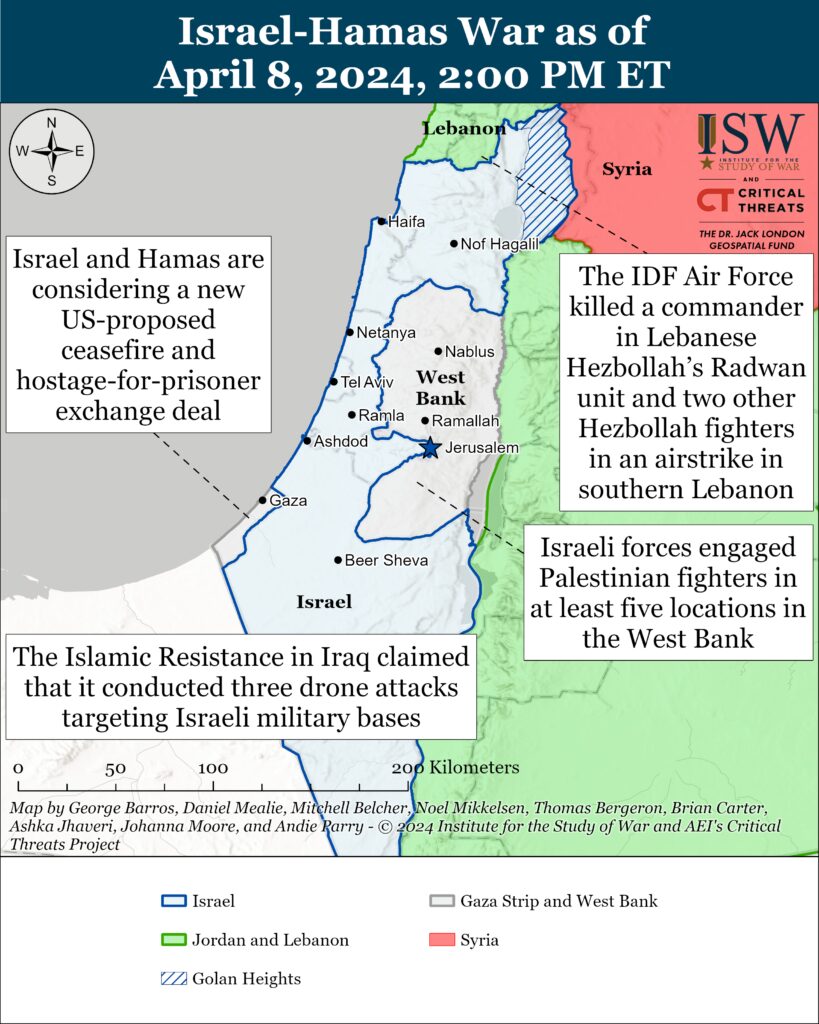
Gaza Strip
Axis of Resistance objectives:
Erode the will of the Israeli political establishment and public to sustain clearing operations in the Gaza Strip
Reestablish Hamas as the governing authority in the Gaza StripPalestinian sources reported that Israeli forces are still present in the Central Gaza Strip and in southern Gaza City on April 8. The IDF withdrew all its forces in the southern Gaza Strip on April 7, but the IDF Nahal Brigade remains at the seam of the northern and central Gaza Strip to secure Israeli-built highway Route 749 and other Israeli military sites in the area, which the IDF has dubbed the Netzarim corridor.[xlii] The Nahal Brigade’s presence on the road also prevents Palestinian civilians from returning to the northern Gaza Strip from the south. Palestinian sources claimed that Israeli bulldozers operated in eastern Deir al Balah and Maghazi camps area as part of the IDF’s ffort to establish a buffer zone between the Gaza Strip and Israel.[xliii] Local sources also reported Palestinian fighters clashed with Israeli forces near al Kuwait Roundabout in southern Gaza City and near Juhor ad Dik, southeast of Gaza City.[xliv] Palestinian reports of Israeli activity in the northern and central Gaza Strip are consistent with the Nahal Brigade’s limited operations in the central Gaza Strip and the IDF’s transition to a model focused on targeted raids throughout the entire Gaza Strip.
Hamas was the only Palestinian militia to claim an attack targeting Israeli forces operating in the Gaza Strip on April 8. Hamas said that its fighters mortared the IDF Nahal Brigade headquarters along the “Netzarim Axis,” referring the Israeli-built highway Route 749, which bisects the northern and southern Gaza Strip.[xlv] The low number of attack claims is likely due to the IDF withdrawal from the southern Gaza Strip and a lack of target availability. Palestinian Islamic Jihad fighters targeted Israeli forces in Sheikh Ijlin, southern Gaza City on April 7.[xlvi]
Israeli Prime Minister Benjamin Netanyahu said on April 8 that “there is a date” for an IDF clearing operation into Rafah to dismantle the remaining Hamas battalions there.[xlvii] The IDF chief of staff similarly said on April 7 as the IDF withdrew most of its forces from the Gaza Strip that ”the war in Gaza continues, and we are far from stopping.“[xlviii] Israeli officials and media sources framed the April 7 withdrawals as part of the IDF’s preparations for conducting a clearing operation into Rafah.[xlix] Far-right politician and National Security Minister Itamar Ben Gvir said on April 8—in reference to the IDF‘s withdrawal from the southern Gaza Strip—that if Netanyahu decided to ”end the war without an extensive attack on Rafah—he will not have a mandate to continue serving as Prime Minister.[l]
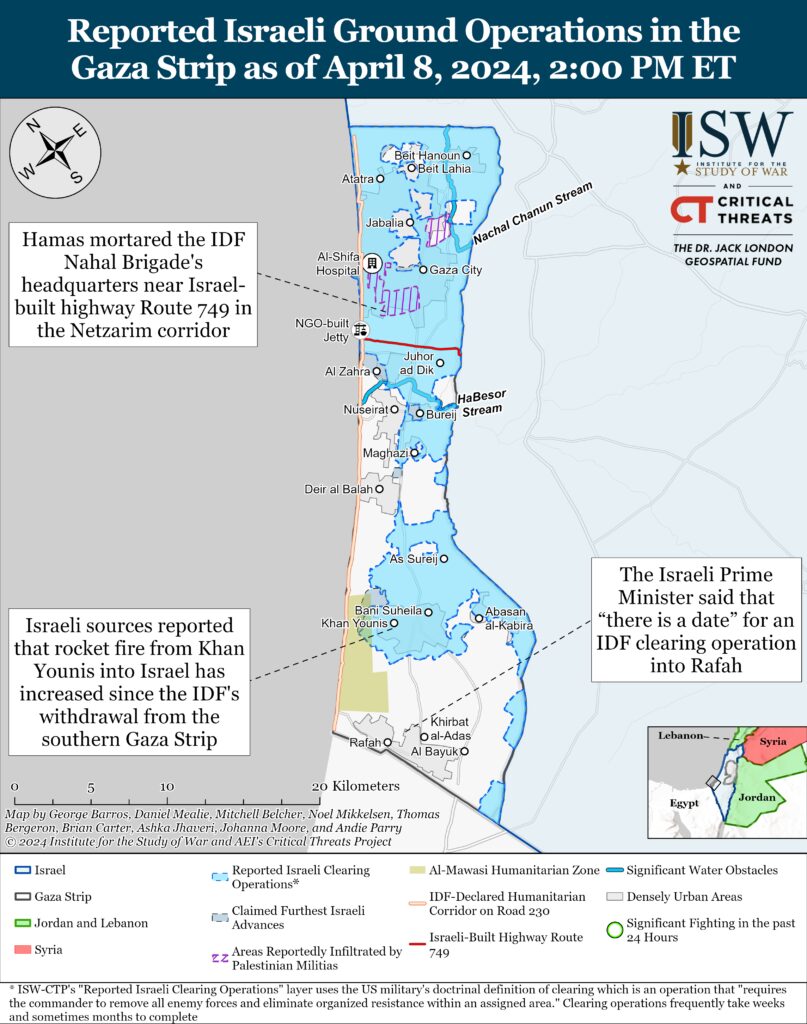
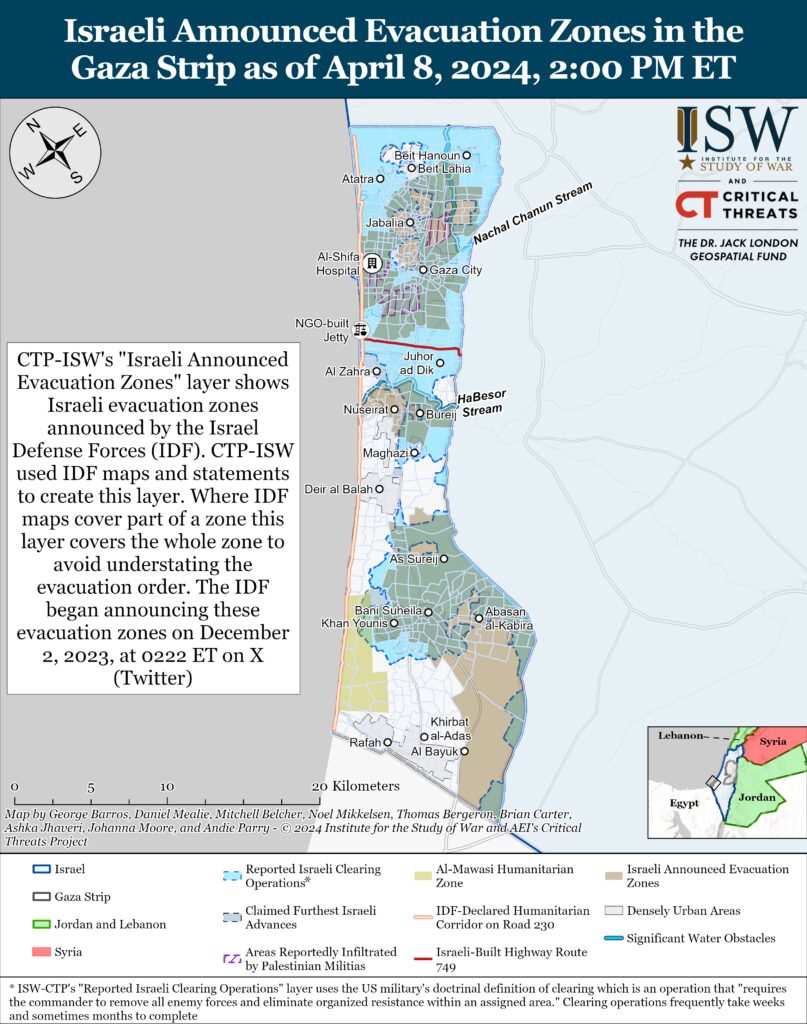
Palestinian fighters fired at least two rocket barrages from the Gaza Strip targeting southern Israel on April 8.[li] The al Aqsa Martyrs’ Brigades, which is the self-proclaimed militant wing of Fatah, and the Democratic Front for the Liberation of Palestine (DFLP), which is a leftist Palestinian militia aligned with Hamas in the war, targeted an Israeli military site near the northern Gaza Strip with a combined rocket barrage.[lii] Israeli Army Radio reported unspecified Palestinian fighters fired one rocket targeting a town that hosts an Israeli military base in southern Israel.[liii]
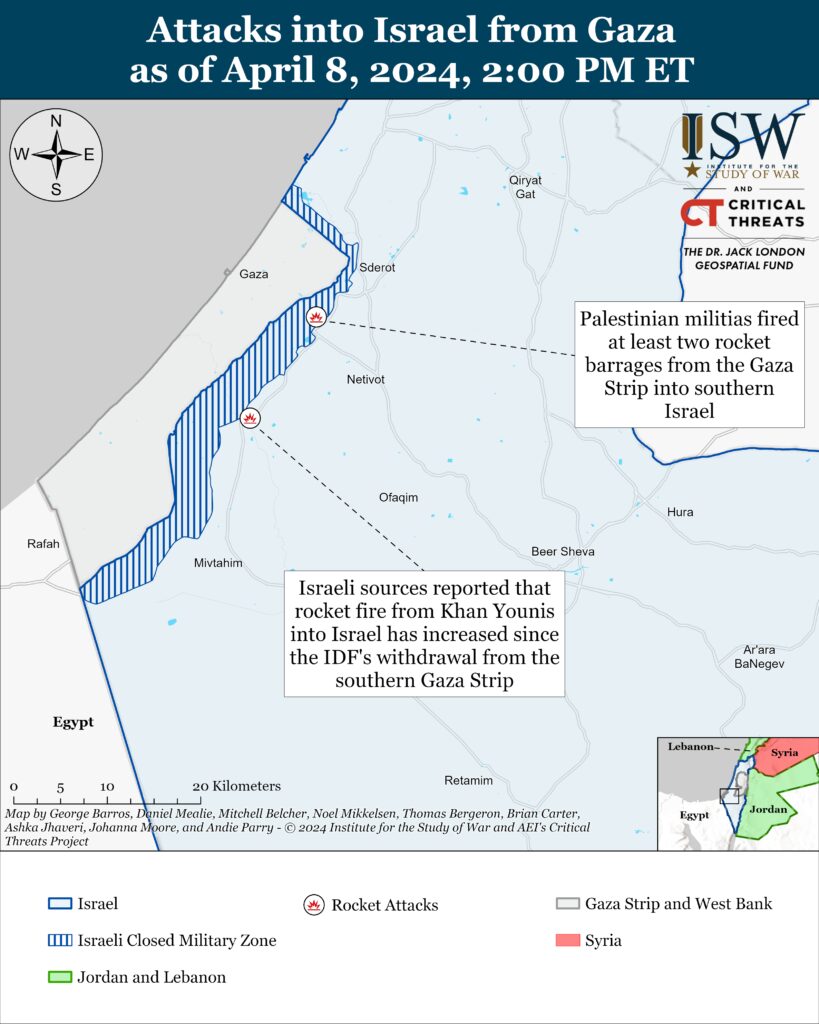
West Bank
Axis of Resistance objectives:
Establish the West Bank as a viable front against IsraelIsraeli forces have engaged Palestinian fighters in at least five locations in the West Bank since CTP-ISW’s last data cut off on April 7.[liv] The al Aqsa Martyrs’ Brigades and Palestinian Islamic Jihad (PIJ) fired small arms and detonated improvised explosive devices targeting Israeli forces during Israeli operations in Tulkarm and the Balata refugee camp in Nablus.[lv] PIJ fighters also fired small arms targeting Israeli civilians across the West Bank-Israel border in the Meirav settlement.[lvi]
Israeli forces detained 11 wanted individuals across the West Bank during overnight raids on April 8.[lvii]
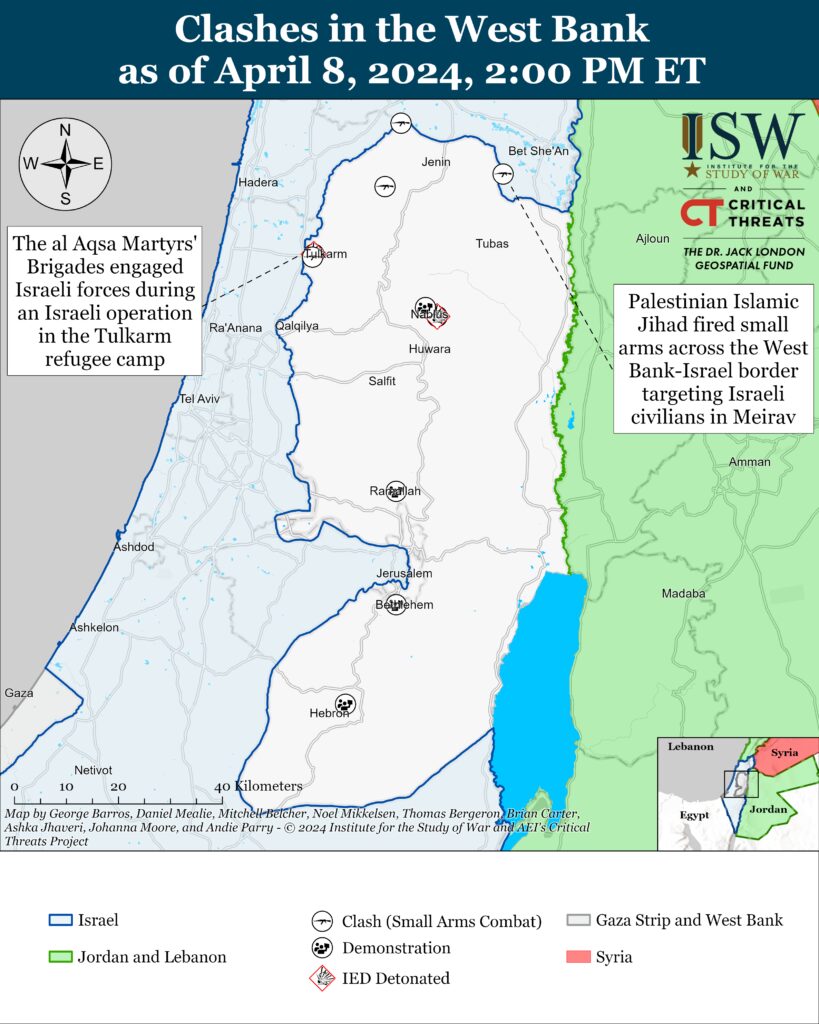
This map is not an exhaustive depiction of clashes and demonstrations in the West Bank.
Southern Lebanon and Golan Heights
Axis of Resistance objectives:
Deter Israel from conducting a ground operation into Lebanon
Prepare for an expanded and protracted conflict with Israel in the near term
Expel the United States from SyriaIranian-backed fighters, including Lebanese Hezbollah, have conducted at least six attacks from southern Lebanon into northern Israel since CTP-ISW’s last data cutoff on April 7.[lviii]
The IDF Air Force killed a senior official and commander in Hezbollah’s Radwan unit and two other Hezbollah fighters in an airstrike in southern Lebanon on April 8.[lix] The IDF said that the commander, Ali Ahmed Hussein, was a “veteran and senior official” for the group and held a rank equivalent to a brigade commander.[lx] The IDF added that Hussein was responsible for planning and executing attacks targeting Israeli forces in Ramim in northern Israel.[lxi] Hezbollah acknowledged Hussein’s death on April 8.[lxii]
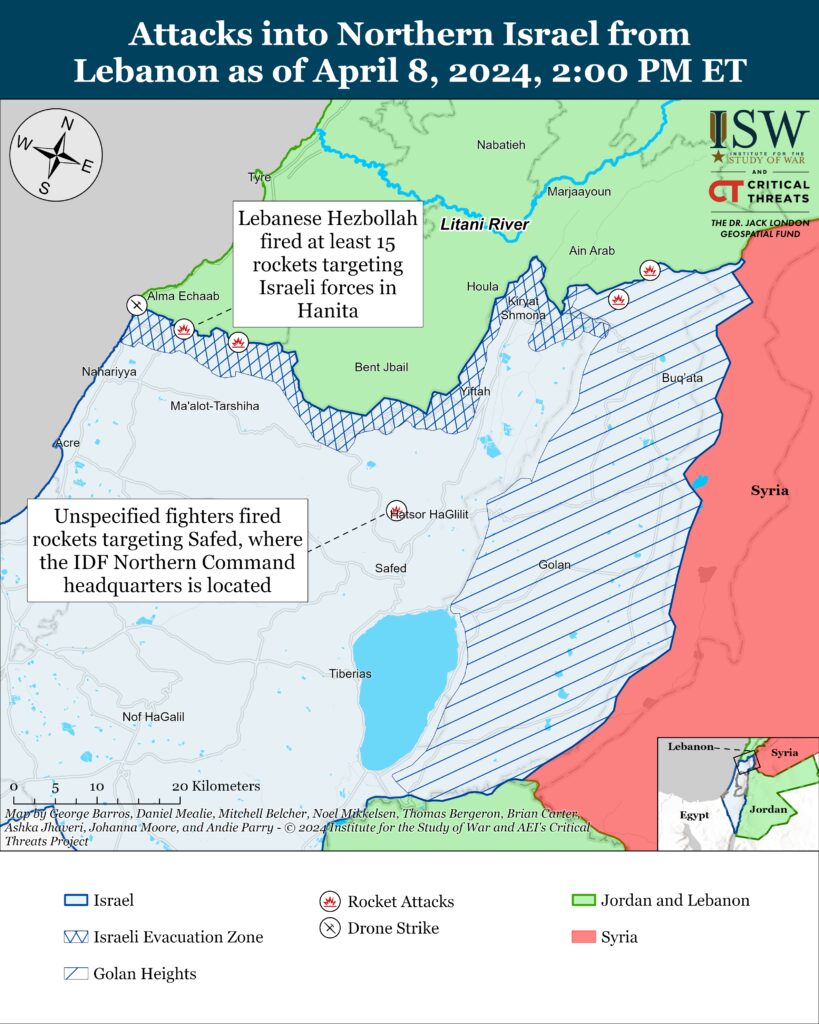
Recorded reports of attacks; CTP-ISW cannot independently verify impact.
Iran and Axis of Resistance
The Jordanian Army killed two drug smugglers along the Jordanian-Syrian border on April 8.[lxiii] Saudi media reported that Jordanian officials said that Lebanese Hezbollah and other unspecified Iran-backed militias are responsible for the increase in drug and weapons smuggling from Syria into Jordan.[lxiv]
The Islamic Resistance in Iraq—a coalition of Iranian-backed Iraqi militias—claimed that it conducted three drone attacks targeting Israeli military bases since CTP-ISW’s last data cutoff on April 7.[lxv] The group claimed that it targeted the “Western Yarden” base in the Golan Heights, the “Elifalet” base near Safed north of the Sea of Galilee, and the “Southern Yohantan” base in the southern Golan Heights.[lxvi] Israeli officials and media have not commented on the claimed attacks at the time of this writing. CTP-ISW cannot verify the Islamic Resistance in Iraq’s attack claims.
US Ambassador to Iraq Alina Romanowski met with Iraqi Prime Minister Mohammad Shia al Sudani to discuss Sudani’s upcoming visit to Washington, DC, on April 15.[lxvii] Iraqi officials previously stated that Sudani’s visit to Washington will focus on the status of the US-led international coalition in Iraq and the “transition to a comprehensive partnership between Iraq and the United States.”[lxviii] Washington and Baghdad began talks to evaluate the status of the US-led international coalition in Iraq in late January 2024. [lxix]
Iranian security forces arrested a “main member” of the Baloch militant group Ansar al Furqan in Zahedan, Sistan and Baluchistan Province, on April 6.[lxx] The Sistan and Baluchistan Province police chief said that the Ansar al Furqan militant previously participated in attacks targeting Law Enforcement Command (LEC) and Islamic Revolutionary Guards Corps (IRGC) headquarters in Iran.[lxxi] A group of “terrorists” separately killed two police officers in Zahedan on April 6.[lxxii] These incidents are part of a rise in anti-regime militancy in southeastern Iran and reflect the increasingly precarious state of the Iranian internal security environment. The Baloch Salafi-jihadi militant group Jaish al Adl most recently conducted unprecedentedly complex and sophisticated attacks targeting Iranian security forces in southeastern Iran on April 4, killing at least 11 Iranian security personnel.[lxxiii]
Iranian police claimed that they arrested three Islamic State operatives in Karaj, Tehran on April 6.[lxxiv] Iranian state media claimed that trio was planning to conduct a suicide bombing at the end of Ramadan.[lxxv]
Afghan media reported that the three individuals are members of the anti-Taliban opposition group the Afghanistan National Resistance Front (NRF) and previously fought against the Taliban in eastern Afghanistan.[lxxvi] The NRF does not target civilians and does not use suicide bombings as part of its operations against the Taliban government in Afghanistan. Pro-Taliban social media users used Iran’s arrest to advance an information operation that claims that the National Resistance Front and Islamic State Khorasan Province (ISKP) cooperate to conduct terror attacks.[lxxvii] The NRF wants to restore the former Islamic Republic of Afghanistan while ISKP is a Salafi-jihadist group that wants to implement Sharia law in central and south Asia as part of a global caliphate. The two groups’ worldviews and ideologies are diametrically opposed to each other.
 Eurasia Press & News
Eurasia Press & News




